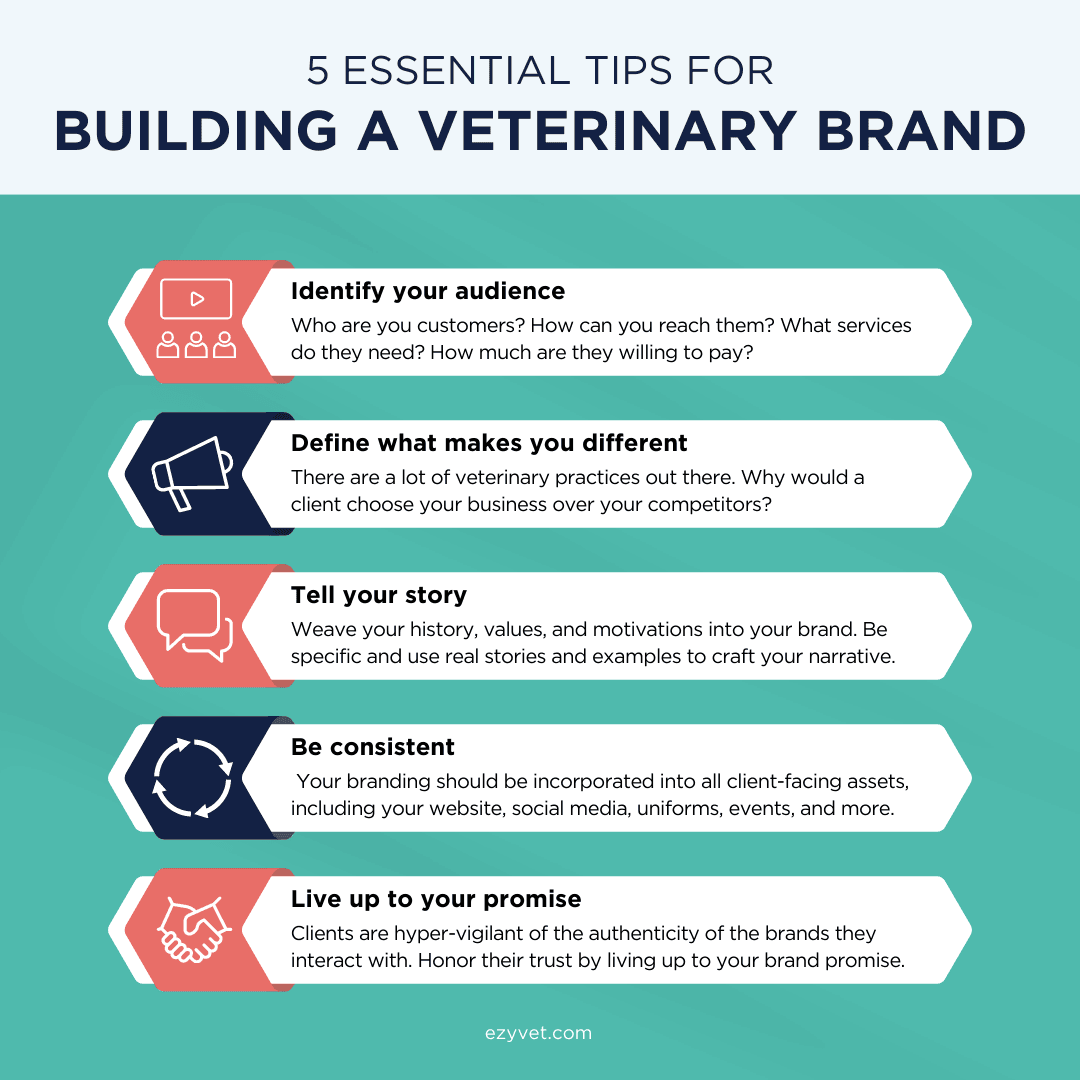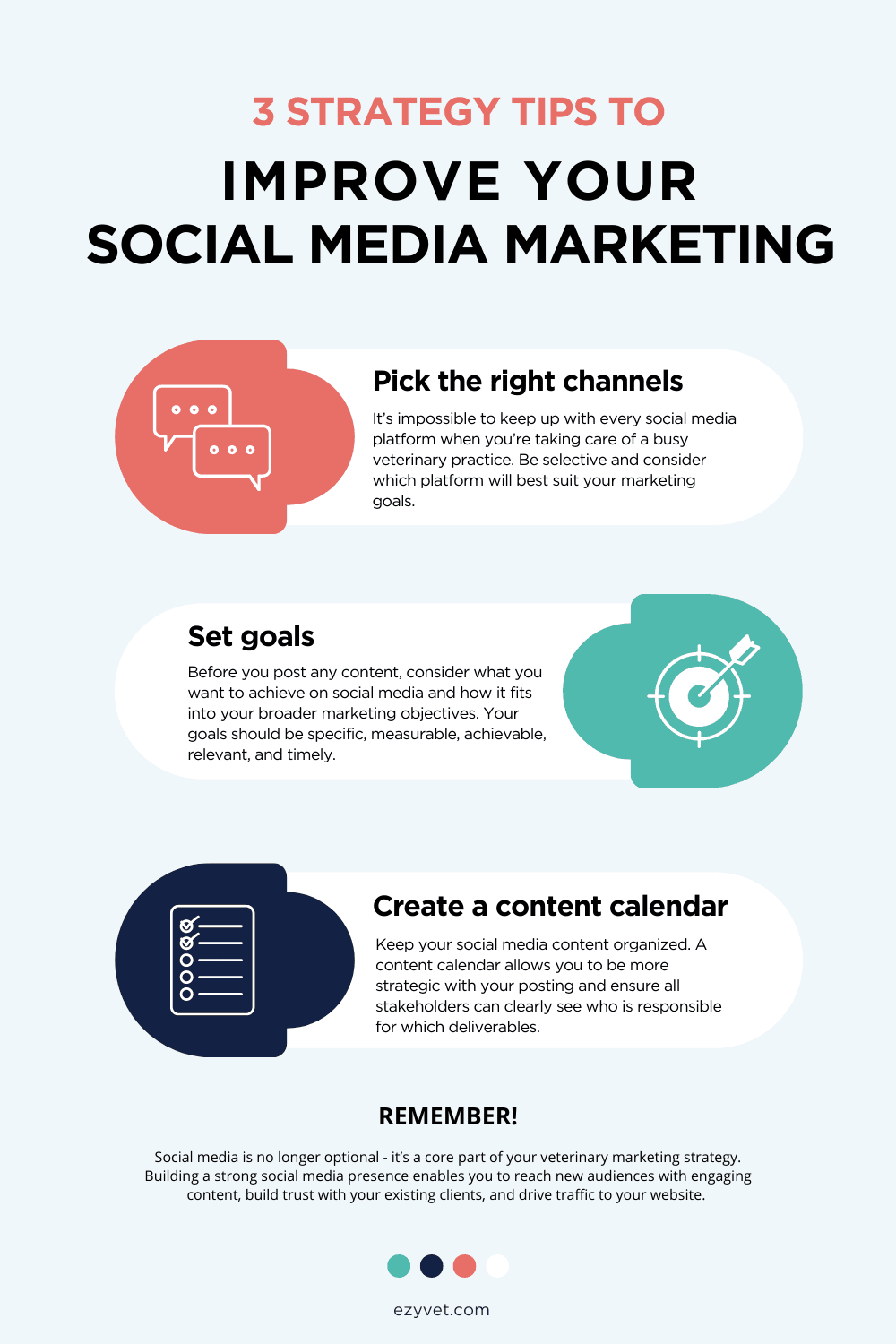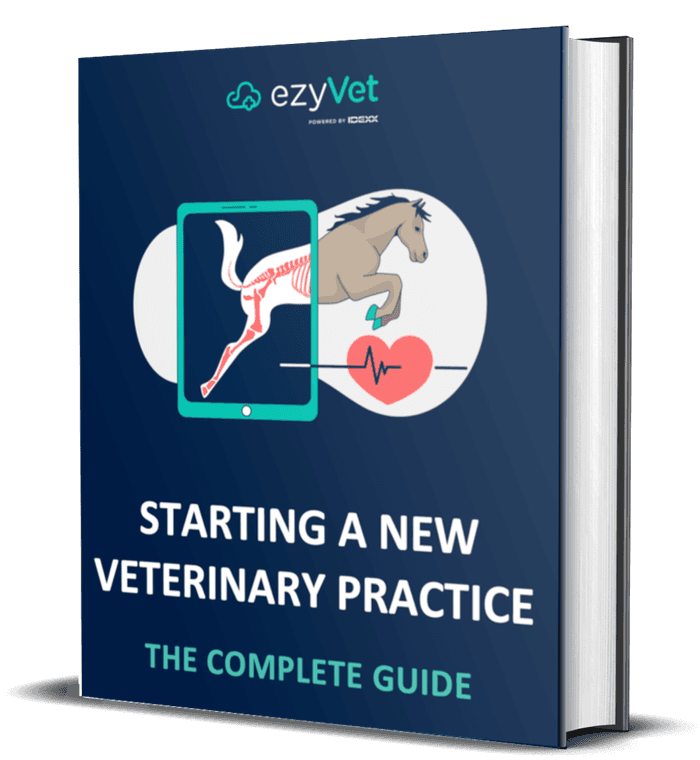The complete guide to veterinary marketing
In today’s competitive veterinary landscape, passion alone isn’t enough to guarantee business success - you’re going to need a marketing plan.


In today’s competitive veterinary landscape, passion alone isn’t enough to guarantee business success - you’re going to need a marketing plan.
Enter your details to download our complete guide to marketing your veterinary practice. 📚

Effective marketing starts with a solid marketing plan. A veterinary marketing plan is a document that lays out your marketing goals and the strategies and tactics you’ll use to reach them. It provides you with a clear view of your objectives, audience, and resources, as well as the concrete actions that need to be taken to achieve the anticipated results.
If you’ve never created a marketing plan for your veterinary clinic, the thought of writing one from scratch can be a little intimidating. But you don’t have to do it all at once, and it doesn’t necessarily have to be a super formal affair; simply putting your plan in writing can give you a better understanding of your goals and enable you to make more effective use of your marketing resources. Keeping the plan simple ensures it doesn’t end up in the too hard basket! Here are a few things that your veterinary marketing plan should include:
The first step is to define your objective. What is it you want to achieve? Whether your goals revolve around growing your client base, increasing revenue, or driving product sales, clearly defining your objectives will give you a stronger sense of direction and inform many of your marketing decisions further down the track.
You’ll also need to be mindful of your resources and consider how much you can realistically invest into your marketing efforts in terms of both time and money. Few veterinary practices will have the luxury of working with limitless resources, so focus on the objectives that will ultimately deliver the best bang for your buck.
Make your objectives SMART. That means they should be:
Vague objective: Attract more clients.
SMART objective: Increase client base by 10% in the next six months.
Vague objective: Increase revenue.
SMART objective: Increase sales of canine care products by 5% in the second quarter.
It’s easy to waste a lot of time and money marketing to people who aren’t interested in your services. Defining and truly understanding your target audience will help you reach the market that matters most: the people who are actually interested in your products and services.
Start by going through your records to collect some basic information about your clients. Some good demographic information to look for includes:
After collecting the data, segment your target audience into a few different buyer personas. Buyer personas are semi-fictional representations of your target audience, based on your data, industry knowledge, and experiences with past clients. You may also wish to assign psychographics to your buyer personas, which include subjective data like behavior, needs, interests, opinions, tech savviness, and values.
Fleshing out your buyer personas can be an effective way to get to know your customers better. They also allow you to tailor your marketing material and services to meet the unique needs of your target audience.
Competitor analysis is key to understanding where your veterinary practice sits in the marketplace. Knowing the strengths and weaknesses of your competition can help you find a gap in the market and differentiate your practice from other clinics in the area.
Your competitors are primarily other veterinary practices located in close proximity to your clinic. What constitutes “close” depends on your location. If you’re based in a busy urban area, your competition might be veterinary practices within a tight three or four-mile radius of your clinic. On the other hand, if you run a rural veterinary practice, your competition might be clinics within, say, 15-20 miles of your business.
Once you’ve identified the competition, it’s time to do some research. There are a few places you can easily pull information from, including:
Look at your competition with a critical eye. What are they doing right? What could they improve on? To help you get started, here are a few questions to keep in mind while analyzing the competition:
Write down your answers and keep the document somewhere handy. Gaining insight into your competition sets the foundation for an effective marketing strategy that can help your business stand out from the crowd.
There’s a wide range of channels you can use to achieve your marketing objectives. Some channels are better suited to certain goals than others. A radio jingle, for example, can be a great way to build brand awareness, while a targeted digital advertising campaign may be a better way to convert prospects into paying customers. Your choice of channels will also depend on the size and structure of your business. For instance, a mix of marketing channels that works wonders for a six-doctor emergency hospital may not be the right fit for a one-doctor mobile equine practice.
There’s no one-size-fits-all answer here, so think about what will work best for your objectives, buyer personas, and budget. Digital marketing is often popular with veterinary practices due to its low barrier to entry and potential to deliver great results. This includes channels such as:
Depending on your target audience, traditional channels such as newspaper and magazine, radio, and TV advertising can be effective when used in conjunction with digital marketing methods. However, traditional marketing channels tend to be more expensive and their results less measurable than digital channels. Events, trade shows, and word of mouth remain powerful ways of building brand awareness.
Once you know what you want to achieve, it’s time to put together an action plan. This document details exactly what needs to happen to execute your veterinary marketing plan and who’s going to do it. Your action plan should include:
Don’t gloss over that last point. Establishing the right KPIs is critical for measuring the success of your marketing initiatives and providing you with the insight you need to know what’s working - and what isn’t. Track real-world outcomes and regularly review and refine results to improve future initiatives.
Distribute the action plan to all relevant stakeholders and seek feedback as required. Schedule regular progress reviews to ensure the wider marketing plan is moving along according to plan and intervene sooner rather than later if you notice anything amiss.

Branding is more than a logo or a slogan - it’s the identity of your business. It’s a reflection of what your veterinary practice stands for and what sets you apart from the competition.
Contrary to popular belief, branding isn’t some complicated, expensive marketing strategy that only big companies use. Whether you consciously engage in building a brand or not, your veterinary practice will develop a reputation. Branding is simply an opportunity to guide that reputation in a direction that aligns with your business goals.
Your brand is amplified by your veterinary marketing activities. It’s important to define your brand before launching any new initiatives to ensure your marketing efforts accurately reflect how you want your business to be perceived.
Branding is the act of shaping your audiences’ perception of your business. It involves delivering consistent marketing messaging wherever clients interact with your business. That includes common touchpoints like your company name, colors, logo, slogan, and imagery, as well as less obvious things like staff behavior and wellbeing, your choice of furniture, the layout of your premises, your community impact, your communication style, and more.
All of these things combined contribute to how the world sees your business. That’s your brand. It’s what people think and feel when they consider your veterinary practice, your services, your products, and all the other countless little things that make up your business. Your brand is your company story which, when told compellingly, can help you attract the right clients and maximize your chances of standing out from the competition.
In the eyes of the client, the veterinary industry is fairly homogenous - that is, the services and products provided at one small animal practice are likely to be very similar to those available at another small animal practice. If there’s no discernable difference between practices, the only thing influencing the client’s decision is price. This can quickly lead to a race to the bottom as practices vie to undercut each other.
A strong brand can help differentiate your business in a crowded marketplace. It’s the reason why Nike is the de facto choice of shoe for runners; why Toyota has come to be synonymous with reliability. Sure, there may be some minor functional differences between these companies and their competitors, but the key thing driving their success is the strength of their brand.
People are attracted to brands that they share values with. Communicating these values through your brand can help you build an emotional connection with your target audience and increase the perceived value of your brand - both of which are critical for fostering customer loyalty and capturing repeat business. Research indicates that 57% of customers spend more money on brands they’re loyal to.
As with most marketing efforts, branding starts with research. The key to building a strong brand and developing that all-important emotional connection with clients is to figure out what resonates with your target market, so start thinking about your audience’s pain points and how your business can solve them. You will have already covered a lot of this research when plotting out your veterinary marketing plan in the previous section.
Branding is an opportunity to tell the world what makes your veterinary practice different and, by extension, why a client would choose your business over your competitors.
Your differentiation must be valued by your target market. You might be proud of your staff’s qualifications or your state-of-the-art diagnostic equipment, but if your audience doesn’t care about it or understand its value, it won’t be an effective differentiator.
Remember that your differentiators will not appeal to everyone - and that’s okay. The goal here is to attract your ideal clients (remember the buyer personas exercise from the previous section?), not your Average Joe pet owner.
Here are a just a few examples of attributes that can help differentiate your practice:
It’s important to note that differentiation is not about finding your unique selling point (USP) – the competitive factors that differentiate your products and services from other veterinary clinics. Indeed, given the homogenous nature of the veterinary industry, many clinics may find it impossible to find a genuine USP. Instead, differentiation is about understanding both your actual value and your perceived value, and ensuring you’re communicating those values to your target audience better than your competitors.
Storytelling is a fundamental part of the human experience. Stories make us feel like we’re part of something bigger than ourselves; like we’re sharing an emotional connection with the characters in the story.
Your brand is your story. So, try to weave your history, values, and motivations into your brand. What do you do? Why did you become a veterinarian? How do you feel about your clients? How do they feel about you? These are all fundamental questions to ask yourself as you assemble your brand.
Be specific. Use real stories and concrete examples to craft your narrative rather than relying on general descriptions. People don’t buy what you do, they buy why you do it, so don’t be afraid to let your personality shine through. The more authentic your story, the more like it is that you’ll build an emotional connection with your audience.
If you haven’t yet done so, now is the time to choose a name for your business. A name should be memorable, relatable to your target market, and, most importantly, clearly communicate what your business is about. Abstract names can be catchy (think Google, Xerox, Hulu, etc.), but if you don’t have the budget for large-scale branding, the meaning will likely be lost on your target audience.
If you’re stuck for ideas, think about incorporating one or more of the following elements into the name of your business:
Online business name generators like Namelix can also be useful for brainstorming purposes.
Most jurisdictions have trademark laws in place that prohibit companies from sharing the same name, so be sure to check with your local trademark database before committing to a business name. If you’re based in the U.S., you can use this website to search the United States Patent and Trademark Office.
You can also use Namechk to check the availability of a domain name or social media username.
Brand collateral - your logo, slogan, website, signage, brochures, etc. - is often the first point of contact with your audience, so it’s important to do it right. While it may be tempting to try and whip something up yourself or enlist the help of a creative family member, it’s almost always a better idea to get your branding collateral done professionally. Websites like Upwork can be useful for finding experienced designers at competitive prices, or you may wish to connect with a local design agency or freelancer for a more hands on experience.
This doesn’t mean that you can’t offer some input into the creative process. There are many free tools you can use to express your design preferences, which a professional designer can then use as inspiration to bring your brand collateral to life.
Consistency is the key to a successful branding initiative. Your branding should be consistent and incorporated into all client-facing materials, including:
Branding is all about building trust and fostering an emotional connection with your audience. Now, it’s all on you to honor their trust by walking the walk and living up to your brand promise.
Clients are hyper-vigilant of the authenticity of the brands they interact with. A company that fails to deliver on its promise will quickly lose its customers’ trust, which - given the virality of digital communication - can have far-reaching consequences on a company’s reputation.
The key takeaway here is simple: hold up your end of the bargain. If you’ve built your brand around customer service, you have to be prepared to go above and beyond for every single client. If your brand is all about the user experience, your website better be an absolute dream to use.
Failure to deliver on your brand promise will erode your client’s goodwill and encourage once-loyal clients to take their business to another veterinary clinic that lives up to its promises.

ezyVet is designed in partnership with vets to transform your life, in and out of the practice. Book your demo today.

There’s no other way to put it: if you want your veterinary practice to succeed, you’re going to need a website.
A website isn’t just the backbone of your online presence - it’s one of your most important business assets. It serves as a shopfront window, where your audience can come to learn about your business, your values, your products, and your services. It helps you build credibility, strengthens your brand, and increases the visibility of your business. And it’s also a potent sales tool, guiding website visitors along the transformative journey from casual browser to prospective customer, prospective customer to customer, customer to repeat customer.
To have your website professionally built will probably cost you anywhere from $2,000 to $10,000+, depending on who you hire and the complexity of the website. Many practice owners find this to be a worthwhile investment, given the significant impact a website can have on a business. If you choose to have your website professionally made, feel free to skip ahead to the Website content section below.
It’s never been easier to build a functional, attractive website for very little money. Building your own website gives you complete creative control and the autonomy to make changes whenever you like without having to go through a third-party. However, be warned that building a website can still be a frustrating and time-consuming process - particularly if you’re not very tech savvy.
If you do want to try your hand at building your own website, below is a step-by-step guide.
Your domain name is the address of your website that people type into their browser address bar to visit your website. Your domain name represents your business so it should be closely aligned with the name of your veterinary practice.
Below are some tips for choosing a domain name:
Domain name generators such as Domain Wheel can be a good source of inspiration if you’re struggling for ideas.
Once you’ve settled on a domain name, you’ll need to register it. Some all-in-one website builders (more on those below!) offer domain registration services, but there are a bunch of standalone registrars out there, too, including:
A content management system (CMS) is a software application that you can use to create and manage a website without having to write any code whatsoever (although it can certainly come in handy!).
There are a few popular options to choose from, including:
All-in-one website builders allow you to build websites using simple drag-and-drop functionality, making them the easiest and quickest way to bring your website to life. There are a few different website builders you can use, including Squarespace ($36 per month for the Basic Commerce plan) and Wix ($35 per month for the Business VIP plan). Most website builders manage updates and security for you, which minimizes maintenance time and ensures your site is safe and secure.
Neither Squarespace nor Wix is as versatile as WordPress, but they can be useful if you want to get your website off the ground quickly.
WordPress.org (not to be confused with the more restrictive WordPress.com) is the most popular CMS in the world and accounts for 43% of all websites. It has an extremely active community and more than 50,000 plugins that can add extra functionality to your website. It’s free to use, fairly simple to install, and, due to its widespread popularity, it’s easy to find a website developer to work on your site should you need it. WordPress does not offer hosting, so you’ll need to organize that separately (more on that below). With WordPress, you are responsible for handling all security, updates, and maintenance tasks. Outdated and/or poorly developed plugins can pose a serious security risk.
WordPress can be a little daunting to the uninitiated, but its sheer flexibility makes it an excellent option for veterinary practices of all sizes.
Website hosting providers deal with the infrastructure required to host a website on the World Wide Web. All the files that make up your website are stored on your web host’s servers and made available for viewing online. Connecting your domain name to your web host ensures that when a visitor types in your website address, they’ll be transported to your website.
There are hundreds of hosting services on the market, with prices ranging from $2 to $150+ per month, depending on server type and the level of support you require. Some popular web hosts include:
Some all-in-one website builders provide free hosting as part of their service plans – check the plans for more information.
WordPress, Squarespace, and Wix offer a bunch of different themes that you can use to quickly change the look and feel of your website. While many WordPress themes are free, premium themes tend to offer better security and support, so don’t be afraid to spend a bit of money here to get your website looking the way you want.
One thing you’ll need to keep in mind when tinkering with the design of your website is that your site must be responsive. Responsive web design is all about creating websites that look good on all devices, regardless of the size of the screen. This has become increasingly important as more and more people search for products and services on mobile devices rather than laptops and desktop PCs. In 2021, 57% of global web traffic originated from mobile devices.
If you’re planning to sell products through your website, you’ll need an e-commerce platform to facilitate sales.
Squarespace offers an integrated e-commerce platform as part of its Commerce subscription plans, while Wix includes a user-friendly Shopify extension in its Business and eCommerce plans.
If you decide to go with a WordPress site, WooCommerce may be your best bet. As one of the most popular e-commerce platforms in the world, WooCommerce is extremely customizable and offers a bunch of different themes and plugins that allow you to set up your online store exactly the way you want it.
Shopify (or Shopify Plus) is a good option if you’re interested in a standalone e-commerce solution. It’s easy to set up and requires no coding, which makes it easy to get your online store up and running. The downside is that Shopify is not as flexible or customizable as WooCommerce. Shopify is technically hosted separately from your main website, so you’ll need to link from your website to your Shopify store unless your website has a Shopify integration.

Once you’ve set up the infrastructure of your website, the next step is to build out the content. This may be your clients’ first point of contact with your business, so think about your audience and the type of information they would expect to find on your website. This can vary from business to business, but generally speaking, there are seven fundamental pages that every veterinary website should have.
The homepage is the front door of your website and likely one of your most frequently viewed pages. About 50% of visitors leave a website within 8 seconds, so aim to create a homepage that captures their attention and entices them to view the rest of your website.
The homepage should include:
The main purpose of an About page is to inform readers about your company, what you do, and why you do it. More than a sterile corporate resume, the About page is an opportunity to tell the story of your business and prove your trustworthiness to website visitors.
The About page should answer the following questions:
The Services page describes all the services you offer at your veterinary practice. Your audience has come to your website looking for answers, so try to organize your services in a way that’s clear, concise, and easy to digest for the reader. This might involve creating an overarching Services page, along with sub-pages for each individual service.
Each service sub-page should include:
Your audience needs to be confident that they can trust you with the health of their beloved pet. A meet the team page can be an effective way to establish this trust and help potential clients get to know the real people working behind the scenes of your business.
The meet the team page should include:
The Contact page is just that: a page with your contact information that website visitors can use to get in touch with you. You may also wish to include contact information in other easily accessible parts of your website, like your footer and/or header.
The contact page should include:
An inquiry form can also be included on the Contact page - just be sure to make it optional. Concerned pet owners expect quick answers and forcing them to fill out a form is likely to result in losing a potential booking. Keep the inquiry form concise and only ask for essential information such as name, phone number, and email address. An inquiry form can also include a field for visitors to optionally add a text note if they wish.
A privacy policy sets out how you gather, share, process, and manage your visitors’ personal information and data. Depending on what type of data you collect, you may be legally required to have a privacy policy on your website.
There are a number of online generators - like FreePrivacyPolicy and GetTerms - you can use to create a privacy policy for your website for cheap. However, the best way to create an airtight policy tailored to your business is to hire a lawyer.
The privacy policy doesn’t need to be displayed front and center, so link to it in your footer instead of your more prominent navigation bars.
You’re usually not legally required to have a terms of use page on your website, but it’s still a good thing to have. A terms of use page can help limit your liability and protect your rights to the content on your website.
A terms of use page may include:
There are online generators that can help you create a Terms of use page, but for more comprehensive protection it’s recommended that you talk to a lawyer. As with the Privacy policy page, link your Terms of use page in the footer where it can be accessed if needed without taking up a lot of screen real estate.
In addition to the above fundamental pages, there may be other supplementary pages that are relevant to your veterinary practice that you wish to add to your website. This could include.
Enter your details to download our complete guide to marketing your veterinary practice. 📚

The best website in the world is ultimately pointless if you don’t have any web traffic.
But you know who does have web traffic? Google. The search giant processes some 63,000 searches a second. That’s 5.6 billion searches per day and around 2 trillion searches annually.
Google Ads is the single most effective way to capture a slice of the action. A potent advertising weapon for animal hospitals big and small, Google Ads can help you dramatically expand your reach and attract quality web traffic by slingshotting your business to the top of the search engine results page.
If budget permits, working with a good Google Ads agency will typically yield the best results. However, it’s also possible to get great results running your own ad campaigns, provided you have the time (and patience) to do the legwork.
Google Ads is Google’s advertising program. With Google Ads, you can create online paid advertisements that appear in search results on google.com and millions of third-party websites via the Google Display Network. You can choose where your ads are displayed, set an ad spend that’s appropriate for your budget, and easily measure the results of your campaigns.
Google Ads operates on a pay-per-click basis, which means you only pay for the ad when someone actually clicks on it. The more people who are competing for your audience, the higher the cost of the click.
Once you’ve set up your Google Ads account and created your first campaign, you’ll need to think about what keywords to use.
Keywords are the words and phrases that are used to match your ads with the terms people are searching for. The results that appear on the Google search engine results page - whether they’re organic results or paid ads - are displayed there because they contain keywords that are relevant to the user’s search query. If you want your ads to show up in those results, you need to use those keywords in your advertising campaigns.
A good keyword list can make or break your Google Ads campaigns. So, how do you find good keywords?
Put yourself in your customer’s shoes. What would your buyer personas type into Google if they were looking for your business? Remember, these people aren’t veterinary professionals, so the language you might use to describe your clinic might be very different from the language your audience would use.
There are a bunch of keyword discovery tools you can use to brainstorm good keywords and get some insight into your what your clients are looking for, including:
Be specific with your keywords. While a general keyword like “veterinarian” might receive a lot of searches, there’s not a lot of intent behind it - in other words, the people who click on the ad probably aren’t interested in making a purchasing decision at that particular moment. That means you’re paying for clicks that aren’t delivering revenue.
Single keywords (short-tail keywords) tend to generate a lot of traffic but are often too generic to be of much value. Longer keyword phrases (long-tail keywords) get less search traffic but usually have a higher conversion rate.
Using localized long-tail keywords can be an effective way to attract quality traffic. Consider the following:
Short-tail keyword: vet
Long-tail keyword: exotic animal vet clinic in Houston
Short-tail keyword: emergency vet
Long-tail keyword: emergency vet in Manhattan
Short-tail keyword: vet clinic
Long-tail keyword: puppy vaccinations in New Orleans
In the above examples, people who search for long-tail keywords are more likely to bring in high-intent traffic. Keep in mind that if your keywords are too specific, you might not be able to generate any meaningful volume of traffic. Continuous testing and refinement are key to finding the right balance of keywords. Be ruthless. Kill the ads that don’t work, refine the ads that do work, and keep testing. It’s easy to blow a lot of money on open-ended keywords that people are already spending money on.
Perhaps the most important metric to consider is a keyword’s cost per click (CPC). This number represents how much it’ll cost you every time somebody clicks on an ad featuring that keyword. Longer and more obscure keywords tend to be less expensive as there are fewer advertisers competing for them; shorter keywords are generally more expensive because there’s more competition.
Your audience might use different search terms for your products or services, so try to include all the common variations in your keywords. For example, people who are looking for your business might type in:
Your keywords help get your ads in front of your audience. The content of your ads is what convinces potential buyers to click.
Text-based Google Ads are made up of three key components:
Compelling ad copy is as much of an art as it is a science. Below are some tips to keep in mind:
A/B testing (sometimes referred to as split testing) is the process of comparing two versions of the same marketing asset and measuring the difference in performance to see what works and what doesn’t.
For example, you could run the same ad with multiple headlines to learn more about what type of headline resonates best with your audience. Or you could experiment with different wording in your call to action. Or you could split test your choice of keywords, or demographic, or landing page content, or just about any other variable you can think of.
You probably won’t strike gold with your first batch of ads - and that’s perfectly fine. What is important is that you continue to refine your ads by continuously measuring the results of your campaigns and using that data to optimize future ads with the aim of improving clicks, conversions, return on ad spend, or CPC.
Check out this ezyVet webinar for more veterinary digital marketing tips.


What your customers have to say about business holds a whole lot more weight than what you say about your business, regardless of how awesome your services are or how authentic your brand might be.
An easy way to capture the opinions of your clients is through Google Reviews. Google Reviews are the online reviews of your business, written by your clients, that Google displays next to your Business Profile in Google Maps and on the Google search engine results page. A healthy collection of Google reviews can greatly boost the credibility of your business and improve your online visibility. Best of all, it’s completely free to use.
Before you start actively collecting reviews, it’s a good idea to set up a free Google Business Profile (formerly known as Google My Business) and claim ownership of your business. This is important because anyone can create a Business Profile, regardless of their relationship with your business. This means anyone - a disgruntled client or ex-employee - could potentially make a profile of your veterinary practice that you would be powerless to manage or control.
With a Google Business Profile, you can take ownership of your business profile, maintain your contact information, post photos of your business, collect and respond to client reviews, and more. Check out this step-by-step guide to learn how to sign up for a Google Business Profile and verify your business.
The easiest way to get some reviews under your belt is to ask! When a client is checking out, take a moment to ask about their appointment and - if they seem to be satisfied with the experience - politely ask if they’d be willing to leave you a quick Google review. You’ll find that many people will be happy to help, particularly if they’ve had a positive outcome or been generally impressed by your service.
Sending a direct link to a review request allows your client to leave a review in privacy and at their leisure, removing most of the obstacles involved with gathering reviews in person. There are many communication channels you can use to follow up with clients and ask for reviews. This could include:
If a client has taken the time to leave you a review, make sure you do the right thing and respond! Think of this as an opportunity to engage with your clients and show your appreciation for their feedback - even if it’s critical. Yes, negative reviews might make you feel angry or upset, but remember that you’re representing your business so ensure that your responses are always on-brand and professional. 82% of consumers will intentionally sniff out negative reviews to see how a business responds to criticism.
Making the time to respond to feedback shows clients that you care about their experience, encourages others to share their own reviews, and indicates that you’re active and ready for business.
If you’re still struggling to get feedback, you might be tempted to offer your clients a little incentive in exchange for a review. Google frowns on this sort of behavior and punishes businesses that it believes are incentivizing reviews. All in all, it’s probably not worth the risk. Just stick to collecting reviews the old-fashioned way - with gentle reminders and top-notch service.

More than half the planet’s population is on social media. The average internet user spends 147 minutes per day scrolling through social media. 74% of consumers rely on social networks to help with their purchasing decisions.
The numbers don’t lie. Social media is no longer optional - it’s a core part of your veterinary marketing strategy. Building a strong social media presence enables you to reach new audiences with engaging content, build trust with your existing clients, and drive traffic to your website.
It’s impossible to keep up with every social media platform when you’re taking care of the day-to-day running of a busy veterinary practice. Be selective and consider which platform best aligns with your audience and marketing goals.
Facebook offers the most value as a veterinary marketing tool for the typical practice. With 2.9 billion monthly active users, Facebook is the most popular social media platform in the world and encompasses all demographics - including your target audience. Facebook also allows you to accurately measure the impact of your marketing efforts via Page Insights, which provides granular information about your audience, post reach, engagement, conversions, and more.
Check out this page to learn how to set up a Facebook page for your business.
If you’re looking for a secondary social media channel to supplement Facebook, consider setting up an Instagram account. Boasting more than 1 billion monthly active users, Instagram is an excellent way to build brand awareness and tell the story of your business through compelling visual content. Both Instagram and Facebook are owned by Meta.
There’s little point in investing time and resources into social media for the sake of it. Before you post any content, consider what you want to achieve on social media and how it fits into your broader marketing objectives. The same goal-setting rules discussed earlier apply: goals should be Specific, Measurable, Achievable, Relevant, and Timely.
Focus on the metrics that matter. Some common examples of measurable social media marketing goals include:
Volume and cadence are important when it comes to posting on social media. You want to post frequently enough to keep your audience engaged and your business front of mind, but not so often that you annoy your followers or rub the social media algorithms the wrong way.
As a general starting point, aim to post:
Stick with this schedule for a month or so before investigating the results. Both Facebook and Instagram offer powerful analytics tools that allow you to measure the performance of your posts at a granular level. Once you’ve got some data to work with (for example, the types of content that receive the most engagement and the times that your audience is most active on social media), you can adjust your posting accordingly and develop a strategy that works best for your specific audience.
Posting content across multiple social media channels can be time-consuming. To simplify the process, Meta Business Suite allows you to quickly schedule posts on both Facebook and Instagram and cross-post content between the two platforms.
There are also a bunch of third-party tools you can use to schedule automated posts on Facebook and Instagram, as well as other social media platforms. Some of the most popular options include:
About 63% of businesses don’t have a clearly documented content strategy. To keep your social media posts organized, it’s a good idea to use a content calendar. A content calendar is simply a written schedule of when and where you plan to publish your upcoming content. It’s an effective way to visually organize your social media efforts and ensure that all stakeholders can easily see who is responsible for which deliverables.
You can create a basic content calendar with a spreadsheet, or you can use a project management tool like Trello if you need a more powerful solution.
Consider who’s going to be responsible for posting on social media. In larger veterinary practices, responsibility will probably fall to the marketing team, but there are other options if you don’t have dedicated marketing personnel:
Facebook’s algorithm tends to prioritize posts from users’ friends and family, which makes it all too easy for your posts to get lost in the mix. On average, the content post a Facebook business page only reaches about 1 in 20 of the page’s followers. The easiest way to boost that distribution rate is to set up some paid Facebook ads.
There are a couple of different types of Facebook ads:
As a general rule of thumb, Facebook ads are a good option if you want to create advanced advertising campaigns, while boosted posts are an easy way to build brand awareness and drive audience engagement.
All content that you post on social media should offer some sort of value to your audience, whether it’s educational, informative, entertaining, etc. All social media messaging should be in line with your brand and relevant to your services and goals. Sharing a trending meme might drive a lot of engagement, but it’s probably not going to result in more leads.
Below are some examples of content you should and shouldn’t share on social media.

ezyVet is designed in partnership with vets to transform your life, in and out of the practice. Book your demo today.

Effective veterinary marketing isn’t just about client acquisition - it’s also about keeping your current customers loyal and engaged.
The average companion animal practice loses 10-15% of its client base each year. Given the comparatively high cost of client acquisition - acquiring a new client costs around five times more than retaining an existing client – client attrition can have a major impact on revenue
Sometimes, client attrition occurs due to factors outside of your control, like the client moving to a new city or the death of the patient. But a certain portion of defectors will leave for reasons that likely could have been prevented. This includes things like your hours of operation, communication style, client experience, perceived employee performance, etc.
Below are some practical veterinary marketing tips to help minimize the risk of customer attrition.
Providing your clients with valuable educational resources can be an excellent way to demonstrate your expertise and strengthen client relationships. The goal of the content should be to educate clients about health conditions relating to their pets and the potential consequences of not addressing these concerns. Educational content can take many forms, including blog posts, videos, webinars, photos, and infographics, and should always include a strong call to action.
Creating content from scratch can be time-consuming, but the good news is that some organizations offer high-quality client education materials for free. For example, the American Veterinary Medical Association has a huge library of free pet care resources available for download. You can also choose to purchase them printed if you wish to stock physical copes in your practice.
Content can be distributed across all your major communications channels on a regular basis. Increasing the frequency of your touchpoints between visits through educational - as opposed to promotional - content helps keep your veterinary practice front of mind when your customer thinks about pet care without your brand coming across as overly salesy.
Effective communication is a key ingredient in fostering strong client relationships. Regular communication – including proactive appointment reminders – drives customer satisfaction and makes your clients feel like they’re part of a community, while also helping your practice secure more bookings.
The average office worker receives upwards of 120 emails per day. To cut through the noise and ensure your message is heard, consider using multiple channels to deliver your communications. SMS, for example, boasts an incredible 98% open rate, which means practically everyone you send a text message to will actually read it. Check out how this veterinary clinic used SMS to boost client compliance and increase revenue.
To minimize admin time, client communications should be largely automated. Some practice management solutions, including ezyVet, enable you to automatically send personalized communication reminders to your patients via both SMS and email.
Clinics of all sizes must actively strive to retain talented veterinary staff. Your staff - and your client-facing staff, in particular - play a key role in how your customers perceive your practice. Friendly customer service and quality pet care are key ingredients for building relationships and nurturing the emotional connection between clinic and client.
Clients put a lot of value in these relationships, especially as authentic personal service becomes harder to come by in the era of megastores and online shopping. Therefore, high staff turnover rates can directly contribute to client attrition. The loss of familiar faces at the practice can be alienating for your regular clients, while new staff may not yet have the experience to deliver the level of service that your clients have come to expect. In addition, a veterinarian who moves to another clinic may end up taking some of your client base with them.
However, holding onto quality staff is easier said than done. The average veterinary hospital has a staff turnover rate of 23% per year and the average career length of a veterinary nurse is less than seven years. A comprehensive staff retention strategy is beyond the scope of this guide, but the following veterinary marketing tips may be useful as a starting point:
Check out ezyVet’s RACE CE approved webinar for more information on tackling the veterinarian shortage.
Attrition often occurs when a client feels their needs are no longer being met. To ensure your veterinary practice is ticking all the right boxes, it’s important to actively seek input from your clients and frontline staff and take steps to address their feedback once you’ve gathered sufficient data.
There are a few ways to collect feedback, including:
Customer loyalty programs have become commonplace in the veterinary industry, but opinion is split over their effectiveness. Advocates believe customer loyalty programs can help increase sales revenue and reduce client attrition, while detractors say they can harm a clinic’s already-slim profit margins and do little to improve retention rates.
If you do decide to implement a loyalty program, it’s important to design a program that doesn’t exclusively rely on discounts or monetary compensation. If your practice nets 10% profit, for example, it may not be sustainable to offer repeat clients a 10% discount in exchange for their loyalty. Be strategic about your loyalty rewards and aim to offer gifts and bonuses that are low in delivery cost and high in value perception.
There are many ways to create reward programs without offering discounts. Some examples include:

Check out the complete guide to starting a new veterinary business from scratch. Every step: from the groundwork preparations to the business plan, legal requirements to insurance, recruitment to opening day.

In the modern veterinary landscape, digital marketing undoubtedly rules the advertising roost - but that doesn’t mean that you should ignore traditional channels.
Print advertising, signage, business partnerships, and on-the-ground community initiatives give you the opportunity to engage with local audiences on a personal level that simply can’t be achieved through digital channels.
Signage is an important part of your business. Signage can reinforce brand character, direct clients to your business, and help you make a good first impression. Whether it’s a portable banner, storefront sign, commercial awning, vehicle graphic, or freestanding street sign, all signage should be professionally designed and installed.
Signs should use simple, on-brand fonts for readability and placed strategically to ensure maximum visibility. If you run a 24-hour clinic or are located in an area that receives a lot of after-hours traffic, consider investing in LED signage to ensure round-the-clock visibility.
Affordable, convenient, and easily distributable, branded business cards are an effective way to promote your veterinary practice and build your contact base. Business cards typically cost around $0.20-$0.30 per card, although printing costs can vary depending on paper weight, material, finish, size, shape, colors, and whether the card is double-sided.
Design agencies usually charge around $500-$1,500 for a bespoke, on-brand business card design. For cheaper options, think about connecting with a freelancer but bear in mind that you often get what you pay for.
There are also anti-litter laws that may prohibit you from posting flyers in public areas or on cars. To learn more about these restrictions, contact your city government office before distributing your flyers.
Printed flyers can be a good way to promote your business and are particularly effective in tight-knit communities and areas with a high volume of foot traffic. Flyers can also be used as educational resources and handed out as take-home assets for clients to learn more about specific, relevant topics.
Flyers can be distributed to offices, business lobbies, community notice boards, school events, and retail countertops property - just be sure to ask the owners first and get their approval in writing. Many businesses will be happy to display your printed flyers, particularly if you offer to return the favor.
It’s important to note that you cannot legally place flyers in mailboxes or attach them to private property. If you want to mail your flyers to your local community, you’ll need to do so through the USPS. The USPS’s Every Door Direct Mail service can be useful if you’re looking to distribute mail in bulk.
There are also anti-litter laws that may prohibit you from posting flyers in public areas or on cars. To learn more about these restrictions, contact your city government office before distributing your flyers.
Getting involved in the community is an opportunity to expand your reach, connect with your audience on a personal level, and raise your profile in the community - all of which can help strengthen client loyalty. Research shows that 77% of consumers feel more motivated to purchase from companies that are committed to making the world a better place.
Getting involved in the community doesn’t necessarily have to be an expensive endeavor. In many cases, it may be a matter of volunteering your time or expertise rather than providing financial support. However, you’ll probably still find more opportunities for involvement than your business has resources to address - and not every opportunity will help equally with achieving your marketing objectives. While community initiatives don’t necessarily have to deliver business benefits, it’s still good practice to be judicious with the activities you choose to get involved with and consider how they align with your marketing goals.
Below are some examples of community organizations that a veterinary practice could get involved with:
Building relationships with other established pet-related businesses can be an effective way to get your brand in front of new audiences that are already interested in pet care. Ideally, this should be a mutually beneficial relationship that allows both businesses to build brand trust and attract new clients along the way.
Partnerships take many shapes and forms. For example, you could reach out to businesses in adjacent verticals with an exclusive offer or discount to their customers. Larger businesses may have existing partner programs with established rules and guidelines that need to be followed.
There should be no overlap between the services you offer and the services offered by your partner. There are many types of businesses that are closely (but not directly) related to veterinary care, including:
Newspaper ads are generally best suited to veterinary practices with an audience aged 35+ and are typically most effective in smaller community papers whose readers are likely to live in close proximity to your veterinary clinic.
A traditional newspaper ad can be used to promote a new practice, a relocation, or the addition of new services. Advertorials - such as an animal care information column that includes references to your practice - can be effective.
Cost varies enormously depending on circulation, ad size, ink color, and the day of publication. A full-page newspaper ad in your local newspaper might cost $1,000, while a full-page color ad in The Wall Street Journal might run more than $200,000.
While billboard advertising can help increase awareness of your business, its effectiveness hinges almost entirely on location. You must have a good understanding of the area and the people who live there before considering this form of advertising.
Cost varies significantly depending on the location of the billboard, demographics, traffic volume, and projected impressions. As a general guideline, you can expect to pay:
Rotating billboards, where you share advertising space with other companies, typically cost less.
There may be other costs to consider in addition to the billboard rental costs. Agencies typically charge $100-$500 per hour for billboard designs. You might also have to pay extra for materials and installation costs, so be sure to check with your prospective billboard provider.

Like most veterinary professionals, you were probably drawn to the veterinary industry out of a love for animals, a passion for helping creatures of all species, and a desire to effect real change in your community. A robust marketing strategy is crucial for ensuring that all your hard work is aligned with those big-picture objectives.
Think about what success looks like for you and the actions you need to take to achieve them. In its purest form, that’s all veterinary marketing really is - a strategy for building relationships with your target audience so you can run a profitable business while providing the highest level of patient care possible.